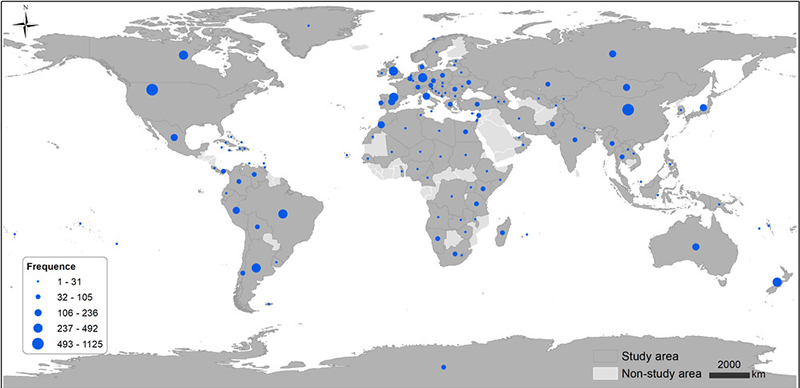Academic Vision - A Decade of Vertebrate Palaeontology Research Reveals Imbalances
A groundbreaking study published in Royal Society Open Science has analysed over 12,000 vertebrate paleontology publications from 2014–2023, offering the most comprehensive snapshot to date of the field’s global trends,gender dynamics, and methodological evolution. Led by an international team spanning China, Argentina, Sweden, the USA, and Australia, the research highlights significant imbalances that could shape future efforts to make the discipline more equitable and globally representative.

Figure. Study areas of new taxa on vertebrate palaeontology during 2014−2023.
Key Findings:
Using the specialized DeepBone database,the team employed bibliometrics, geographic mapping, and AI-driven text analysis (Latent Dirichlet Allocation) to uncover three critical patterns:
1. Geographic Disparities: Of 8,336 newly described fossil species,70% originated from just three regions:
North America (USA: 13.50% of new taxa)
Asia (China: 13.32%)
Europe (e.g.,Argentina: 5.90%, France: 3.86%).
Africa and Oceania contributed less than 10% combined,indicating vast unexplored potential and resource inequity. Mammals (34.72%) and fishes (29.76%) dominated new discoveries globally.
2. Slow Progress on Gender Equity: While female authorship increased from 22.78% (2014) to 27.20% (2023),representation in leadership roles remains low:
Only 22.74% of first authors were women in 2023 (up from 19.83% in 2014).
Male corresponding authors still dominated (75.19%).
Significant regional variations exist: Thailand (57.69% female authors) and Croatia (56%) showed high representation,while major research nations like China (24.01%) and France (25.49%) lagged.
3. Methodological Shifts: Analysis of full-text papers identified 15 major research themes. Core methodologies like phylogenetic analysis (15%), traditional morphology (12%), and high-resolution imaging (9%) remain central but are increasingly integrated with emerging techniques (e.g.,ancient DNA, 3D modelling). The study notes a trend toward interdisciplinary approaches bridging anatomy, evolution, and geology.
Why This Matters
This research provides crucial benchmarks for the paleontological community:
Resource Allocation: It identifies geographic "cold spots" (e.g.,Africa, Oceania) needing targeted fieldwork funding and collaboration.
Addressing Gender Gaps: The slow pace of improvement (~0.44% annual increase in female authors) underscores the need for stronger institutional policies,mentorship,and childcare support to retain talent – especially as nearly 50% of early-career researchers (disproportionately women) leave academia within a decade.
Future-Proofing Research: Mapping methodological trends helps institutions prioritize training in techniques like CT-scanning and geometric morphometrics.
_______
Reference:
Wang H,Sterli J,Dupret V,Blom H,Berta A,Turner S,Han D,Xu L,Pan Z. 2025 A decade of vertebrate palaeontology research: global taxa distribution,gender dynamics and evolving methodologies. R. Soc. Open Sci. 12: 250263. https://doi.org/10.1098/rsos.250263
File Download:
